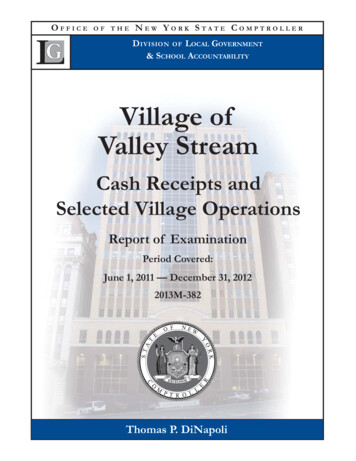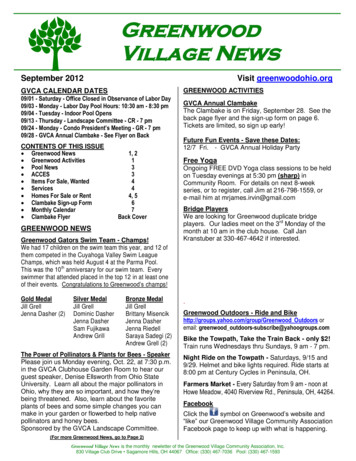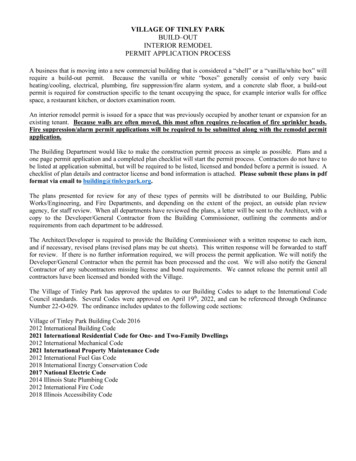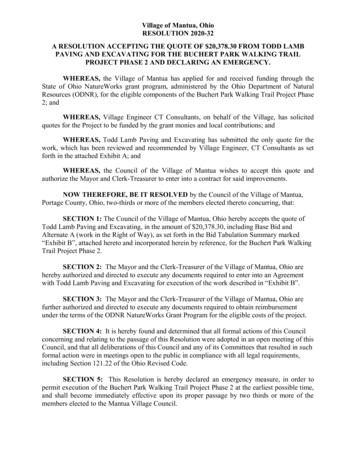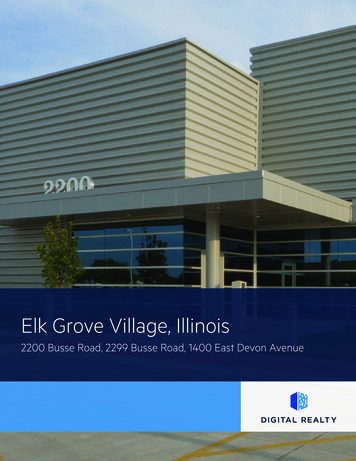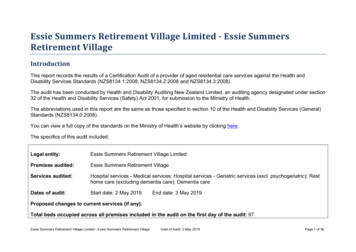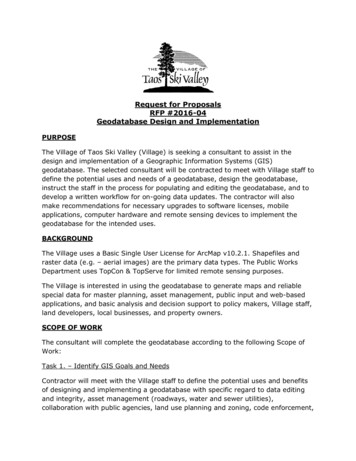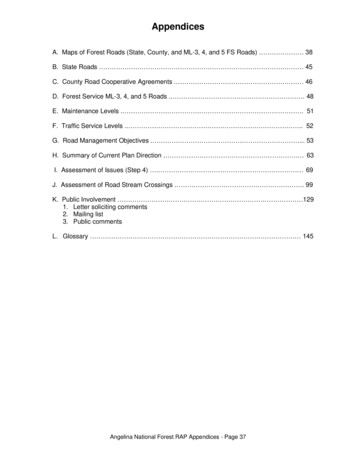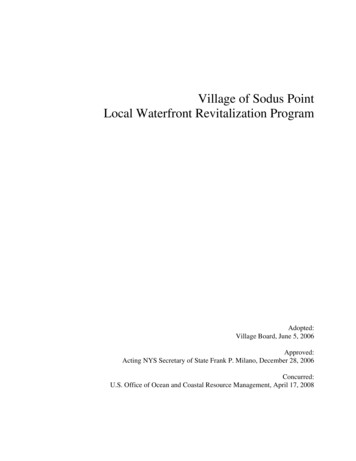
Transcription
Village of Sodus PointLocal Waterfront Revitalization ProgramAdopted:Village Board, June 5, 2006Approved:Acting NYS Secretary of State Frank P. Milano, December 28, 2006Concurred:U.S. Office of Ocean and Coastal Resource Management, April 17, 2008
This Local Waterfront Revitalization Program (LWRP) has beenadopted and approved in accordance with provisions of the WaterfrontRevitalization of Coastal Areas and Inland Waterways Act (ExecutiveLaw, Article 42) and its implementing regulations (6 NYCRR 601).Federal concurrence on the incorporation of this Local WaterfrontRevitalization Program into the New York State Coastal ManagementProgram as a routine program change has been obtained in accordancewith provisions of the U.S. Coastal Zone Management Act of 1972 (P.L.92-583), as amended, and its implementing regulations (15 CFR 923).The preparation of this program was financially aided by a federal grantfrom the U.S. Department of Commerce, National Oceanic andAtmospheric Administration, Office of Ocean and Coastal ResourceManagement, under the Coastal Zone Management Act of 1972, asamended. Federal Grant No. NA-82-AA-D-CZ068.The New York State Coastal Management Program and the preparationof Local Waterfront Revitalization Programs are administered by theNew York State Department of State, Division of Coastal Resources, OneCommerce Plaza, 99Washington Avenue, Albany, New York 12231.
STATE OF NEW YORKD EPARTMENT OF S TATE41 S T A T E S T R E E TA L B A N Y , NY 12231-0001G e o rg e E . P a ta k iC h ris to p h e r L . J a c o b sG o v ern o rS e cretary o f S tateDecember 28, 2006Honorable Michael SullivanMayorVillage of Sodus Point8356 Bay StreetPO box 159Sodus Point, NY 14555Deay Mayor Sullivan:I am pleased to inform you that I have approved the Village of Sodus Point Local Waterfront RevitalizationProgram (LWRP), pursuant to the Waterfront Revitalization of Coastal Areas and Inland Waterways Act.Everyone who participated in the preparation of this program is to be commended for developing acomprehensive management program that promotes the balanced preservation, enhancement, and utilizationof the Village's valuable waterfront resources.I am notifying State agencies that I have approved your LWRP and am advising them that their activitiesmust be undertaken in a manner consistent, to the maximum extent practicable, with the program.I look forward to working with you as you endeavor to revitalize and protect your waterfront. If you haveany questions, please contact George R. Stafford, Director of our Division of Coastal Resources at518-474-6000.Sincerely,Christopher L. JacobsSecretary of StateCLJ:lt\gnW W W .D O S .S T A T E .N Y.U S E- M A I L : IN F O @ D O S . S T A T E . N Y . U S
VILLAGE OF SODUS POINTLOCAL WATERFRONT REVITALIZATION PROGRAMSECTION IWATERFRONT REVITALIZATION AREA BOUNDARYI-1SECTION II INVENTORY AND ANALYSISI.Regional Setting and Community n and HousingGovernmentLand Use and ZoningCounty and Regional PlansRecent Local InitiativesRecent Development ActivitiesII-1II-1II-2II-2II-3II-3II-4II.Existing Land and Water UsesII-5A.B.C.D.E.F.Land UseWater Dependent and Water Enhanced UsesPublic Access to Waterfront and Public RecreationAbandoned, Underutilized and Deteriorated SitesTransportation SystemsPublic Utilities and ServicesII-5II-6II-9II-10II-12II-12III. Natural II-15II-15II-16II-18GeologyCoastal Erosion Hazard AreasWater ResourcesFlood Hazard and Flood Prone AreasFreshwater WetlandsSignificant Coastal Fish and Wildlife HabitatHistoric ResourcesScenic Resources and Important VistasSECTION III POLICIESPolicy 1 – Foster a pattern of development in the coastal area that enhancescommunity character, preserves open space, makes efficient use ofinfrastructure, makes beneficial use of a coastal location, and minimizesadverse effects of development.Policy 2 – Preserve historic resources.Policy 3 – Enhance visual quality and protect outstanding scenicresources.III-1III-9III-16
Policy 4 – Minimize loss of life, structures, and natural resources from floodingand erosion.III-17Policy 5 – Protect and improve water resourcesIII-25Policy 6 – Protect and restore ecological resources, including significant fish and wildlifehabitats, wetlands, and rare ecological communities.III-30Policy 7 – Protect and improve air qualityIII-34Policy 8 – Minimize environmental degradation from solid waste,hazardous substances and wastes.III-35Policy 9 – Improve public access to and use of public lands and watersIII-42Policy 10 – Protect water-dependent uses, promote siting of new water-dependent usesin suitable locations, and support efficient harbor operation.III-49Policy 11 – Promote sustainable use of fish and wildlife resources.III-55Policy 12 – Protect agricultural lands.III-56Policy 13 – Promote appropriate use and development of energyIII-56and mineral resourcesSECTION IV PROPOSED LAND AND WATER USES AND PROPOSED PROJECTSProposed Land UsesProposed Water UsesProposed ProjectsIV-1IV-2IV-4SECTION V TECHNIQUES FOR IMPLEMENTATION OF THE PROGRAMA.B.C.D.Local Laws and RegulationsState Funding SourcesFederal Funding SourcesLocal Funding SourcesV-1V-3V-4V-5SECTION VI STATE AND FEDERAL ACTIONS AND PROGRAMS LIKELY TO AFFECTIMPLEMENTATIONA.B.State and Federal Actions and Programs Which Should Be Undertakenin a Manner Consistent With the LWRPState and Federal Actions and Programs Necessary to Further the LWRPVI-1VI-23SECTION VII CONSULTATION WITH OTHER AFFECTED FEDERAL, STATE,REGIONAL, AND LOCAL AGENCIESA.B.MethodConsultationSECTION VIII LOCAL COMMITMENTVII-1VII-1VIII-1
APPENDICESAppendix A - Significant Coastal Fish and Wildlife HabitatsAppendix B - GUIDELINES FOR NOTIFICATION AND REVIEW OF STATEAGENCY ACTIONS WHERE LOCAL WATERFRONT REVITALIZATIONPROGRAMS ARE IN EFFECTPROCEDURAL GUIDELINES FOR COORDINATING NYS DEPARTMENTOF STATE (DOS) & LWRP CONSISTENCY REVIEW OF FEDERALAGENCY ACTIONS
SECTION IWATERFRONT REVITALIZATIONAREA BOUNDARYWaterfront Revitalization BoundaryThe Village’s Waterfront Revitalization Area (WRA), as related to the Local WaterfrontRevitalization Plan, includes the entire incorporated Village, which is bounded to thenorth by Lake Ontario and to the east by a line that runs south from Sand Point,through Sodus Bay to the southern-most extent of the Village near South Shore Drive.The southern boundary of the Village is defined primarily by the centerlines of MorleyRoad, State Route 14, Bayview Drive and a line to the southeast that approximates acenterline between Bayview Drive and an intersection of South Shore Drive. To thesouthwest, the Village boundary parallels the former Penn Central Railroad. TheVillage line is west and approximately parallel to the former rail corridor and variesfrom 125’-300’ to the edge of the rail right-of-way. The westerly edge of the Village isalso defined by the southern property boundaries of land parcels on Margaretta Road.Portions of the westerly Village boundary conforms to the centerlines of North andMargaretta Roads and an alignment with various property lines between Lake Roadand Margaretta Road. (See Map A entitled Waterfront Revitalization Area Boundary).The waterside boundary for the WRA extends 1500’ into Lake Ontario parallel to theshoreline of the Village limits to the north. The waterside boundary also extends 1500’beyond the shoreline to the east of the Village into Sodus Bay.
SECTION IIINVENTORY AND ANALYSISI.REGIONAL SETTING AND COMMUNITY CHARACTERISTICSA. LOCATIONThe Village of Sodus Point is located in Wayne County, New York, approximately 35miles east of the City of Rochester. The Village is bounded on the north by LakeOntario and on the east by Sodus Bay. On the west and south, the Village abuts theTown of Sodus. The Village of Sodus Point is two square miles (960 acres) in area,with a permanent population of approximately 1,200. It is the primary settlementarea on Sodus Bay.Although it is less than an hour from metropolitan Rochester, the Village retainsmuch of its historic character. The active recreational waterfront on Lake Ontarioand Sodus Bay is a counterpoint to the less developed upland neighborhoods, andareas of wooded and hilly land at the outer perimeter of the Village.The Village of Sodus Point via Sodus Bay offers significant opportunities for access toLake Ontario. Fishermen from throughout of the Northeast and parts of the Midwesttravel to Sodus Point for excellent Lake Ontario sport fishing. Swimming, waterskiing, ice fishing, hunting, boating, bird watching, and sightseeing also drawvacationers from a large region. As a result, tourism plays a significant role in theVillage’s economy.B. POPULATION AND HOUSINGThe following statistics about the Village of Sodus Point from the 2000 Censushighlight some characteristics of the community.The community residential population varies throughout the year. Year-roundhomeowners make up approximately 50% of the total home ownership. Thirty-fivepercent of all homes are seasonally unoccupied, with 15% of the housing units beingrented. 60% of the residents lived in the same household in 1990 as they did in1985, with families making up 70% of total households. Twenty two percent of thefamilies have children under 18 years old resulting in over 264 children in the Villageof Sodus Point attending primary and secondary schools.Sixty-two (62%) percent of the work force commute between 10 minutes and one hourto work. Twelve (12%) percent commute longer than one hour, and four (4%) percentwork at home.Median family income and housing prices are higher than other Wayne Countycommunities. The median household income is 41,272 and the median owneroccupied home value is 84,900.Section II - 1
The housing stock has a median age of 54 years. Five (5%) percent of the housingunits were built between 1985 and 1990. Fifty-six (56%) percent were built before1939, with ninety nine (99%) percent connected to public sewers.C. GOVERNMENTThe Village of Sodus Point is an incorporated village. An elected Mayor and fourVillage Boards of Trustees govern it.There are five Village Departments:Clerk/Treasurer, Highway, Water, Sewer, and Recreation. Parks are managed by theHighway Department. State law provides for the Village Board to approveComprehensive Plans, adopt or amend Zoning Laws, and enact special regulations toprotect community health, safety and welfare.In this regard, the Village has appointed Planning and Zoning Boards. The PlanningBoard is responsible for long-range planning and development review. The ZoningBoard of Appeals (ZBA) hears appeals regarding zoning regulations and may varydevelopment and design standards for reasons of practical difficulty and unduehardship. The ZBA also issues special use permits for development activities whichcan only be approved if found to be appropriate and compatible with theirsurroundings. There is a code enforcement officer who inspects construction forcompliance with zoning and building codes. The Village also has adopted other landuse related laws covering: outdoor entertainment, noise, dock and moorings, floodprotection, parks, sewer use, vehicles and traffic, fire and building codes.D. LAND USE AND ZONINGThe first Village ordinance, enacted in 1958 regulated various types of land use,public safety, and health, but did not include zoning or other types of planninglegislation enabled by State laws. In April of 1964, a Planning Board was created.The first Zoning Map and Zoning Laws were adopted in November of 1969. A zoningmap was updated and modified in 1998. (See Map B - Zoning). The original zoningmap and zoning law was initiated by the completion of a Comprehensive DevelopmentPlan and Model Zoning and Subdivision Ordinance, by the Planning firm of Brownand Anthony in February 1968.The 1968 Comprehensive Development Plan contained individual plans for the Townof Sodus, and the Village of Sodus Point. The Development Plan contained thefollowing recommendations for the Village of Sodus Point, many of which continue tobe appropriate today:1.No development should occur in flood plains, or wetlands.2.Conversion from a seasonal to year-around economy was desirable.3.Promotion of tourism.4.Development of commercial frontage along Bay and Greig Streets.Section II - 2
5.Industrial development of lands west of First Creek and Second Creek,south of Sentell Street to the Village line.6.Upgrading property maintenance, controlling signs, and improving theaesthetics of existing and new development with landscaping.7.Planting street trees along Village rights-of-way.8.From Clover Street to the (then) Railroad Trestle, proposed water enhancedcommercial development.The current Zoning Ordinance closely resembles the model prepared by Brown andAnthony. The Zoning Board of Appeals was created to administer the ZoningRegulations, when adopted in 1969. A Building Code Administration Law wasadopted in 1970. The current Zoning Ordinance was readopted in 1979 and modifiedagain in 1998. The new zoning law was designed to accomplish certain goalsincluding the following: 1) to give priority to water dependent uses within the Village,2) to promote a healthy commercial center which maintains a mix of uses and asuitable scale for the Village, and 3) to protect the traditional scale andcharacteristics of the residential areas. (See Map B - Zoning).E. COUNTY AND REGIONAL PLANSThere have been several plans and studies of the County and region, which haveaddressed the development of the Village of Sodus Point. A separate Wayne CountyTrails Master Plan has tentatively identified enhancement of recreationalopportunities in the Village of Sodus Point as a primary goal. The Village was alsoincluded in a regional study of the Seaway Trail.Wayne County performs several coordinating functions, which may affect futuredevelopment in the Village. The County has prepared an Agricultural PreservationPlan and a County- Wide Economic Development Strategy. The County has ongoingresponsibilities to develop parks and trails, promote tourism and economicdevelopment, obtain grants, review development proposals, coordinate sewer andwater improvements, and improve water quality. The Village is also a part of aCounty Water Quality Initiative. Since 1991, a County Water Quality CoordinatingCommittee (WQCC) has been identifying water quality impairments throughout theCounty. A monitoring station has been installed in Glenmark Creek to test waterquality entering the Bay. A cooperative effort between the WQCC, Soil and WaterConservation District, Save our Sodus (SOS) and SUNY Brockport has also beenmonitoring water quality and fisheries in Sodus Bay.Section II - 3
F.RECENT LOCAL INITIATIVESQuestionnaires have been sent out by the Planning Board over the past ten years tosolicit opinions from residents and property owners about such issues as expandedcommercial and industrial development, historic preservation, public docks, noiseregulations, property maintenance, tourism promotion, recreational opportunities,and revenue generation. In addition, several focus groups related to residential andcommercial development, parks and recreation and fishing/boating activities wereinitiated as part of a Village Master Plan in 1995-96.Several of the most successful projects have been the result of local initiatives. TheLighthouse Museum originated from the interest of a Sodus Point MuseumCommittee in 1972. In 1979 this group incorporated as the Sodus Bay HistoricalSociety. In 1984, the Society entered into a 25- year renewable lease with the Townof Sodus for the Lighthouse, which became its home and has beenmaintained/enhanced for the benefit of the public since. The society sponsorsconcerts, with the financial support of local merchants and foundations. They alsohelp sponsor the 4th of July celebration, Arts and Crafts Shows and other relatedevents. The Fire Department, Methodist Church, Town Chamber of Commerce,Neighborhood Association of Sodus Point and the Yacht Club have annuallysponsored other events such as the Carnival, Sportsman Show, Antique Boat Show,and regattas.The Neighborhood Association of Sodus Point raised the necessary funds thenorganized the community to participate in the installation of a state-of-art playgroundsystem in Willow Park.The Greater Sodus Bay Association (GSBA) participated in the Sodus Point Movienight held at Oscar Fuerst Park (Sodus Point Ball field). 2002 was the first year forthe movie night, but based on public feedback it may become an annual event. Themovies are geared for children and are run at dusk. Karaoke and vendors add to thecharm of the event.Save our Sodus (SOS) has grown to over five hundred members in the year 2002. Asone of their many deeds they recently purchased a weed harvester for the control ofweeds in Sodus Bay. GSBA and SOS have been involved with the evolution of theInter-municipal Harbor Management Plan. They have been working with themunicipalities surrounding the bay, Syracuse University, State and County Officialsand the various regulatory agencies with the primary purpose of making the bay acleaner/better bay for our children.G. RECENT DEVELOPMENT ACTIVITIESThere has been recent investment in marinas, restaurants, hotels and recreation.Although, there has been some new housing, principally along the shorefront, themajority of building is reconstruction of existing structures or complete teardowns ofone or more structures to build a larger home. The Town of Sodus with the Village ofSodus Point and funding from the Department of State recently completed thedevelopment of improved parking, an informational kiosk, landscaping and signageSection II - 4
associated with Harriman Park. Harriman Park is a facility jointly managed andowned by the Town of Sodus and the Village of Sodus Point respectively. The Parkprovides an important boat launch for recreational fishing for the Bay.The Village installed historic style lights throughout the village from 1996-2003. Inaddition, the village completed a project, which made improvements to the VillageGreens.Boat storage facilities have expanded off Margaretta Road along the old railroadcorridor.II. EXISTING LAND AND WATER USESA. LAND USEFormer agricultural land and scattered residential land use occupies the greatestproportion of area in the Village. This land use category includes forestland,brushland, wetlands, and inactive farm fields. This type of land use is generallylocated along Lake Road, with scattered residences as well as in the area bounded bythe former Penn-Central railroad corridor, Route 14, Bayless Road, and Morley Road.Residential uses occupy the second largest proportion of land in the Village.Residential uses are located on both Sand Point and Sodus Point. Homes line theshoreline from the mouth of First Creek, south to the Village line. They are alsolocated in upland areas along Lake Road, Margaretta Road, and Route 14 in theBayless Road area, in the Ontario Street - Fitzhugh Street area, and in Sodus BayHeights.Commercial activity in the Village is primarily located on the waterfront, and tends toserve local residential and tourist needs. Taverns and restaurants are concentrated inthe central business district, along Greig Street. Combined land uses of residentialand commercial occur in several areas including Route 14, Bay Street and GreigStreet. (See Map C - Existing Land Use).Marinas and boat sales are the predominant commercial uses directly on theshoreline, and occupy over 10% of this area. Boat storage areas are located on largeparcels scattered throughout the waterfront area.Lodging is another important element of the Village’s commercial land use. Theseconsist of seasonal cottages, tourist homes, and bed and breakfast establishments.Public parks include the Wayne County Park on Sodus Point; Oscar Fuerst Park(Village of Sodus Point ball field) located near the Greig Street commercial district;Willow Park on Sodus Bay, (south of Greig Street), and the Lighthouse Park andMuseum overlooking Lake Ontario. In addition, there is Harriman Park, a Town ofSodus operated and maintained boat launch located near the mouth of First Creekand an associated (and recently improved) parking area off Margaretta Road.Section II - 5
The estimated size of each park or community owned parcels are as follows:1) Oscar Fuerst Park3.2 acres (Village of Sodus Pt.)2) Willow Park3.1 acres (Village of Sodus)3) Town of Sodus (green space)2.2 acres (remaining from the original 2.9 acres)4) Village of Sodus Water4.3 acres5) Harriman Park4.2 acres (Town of Sodus & Village of Sodus Pt.)6) Water tower in the Heights23.0 acres (Village of Sodus Point)7) Light House1.1 acres (Town of Sodus)8) Village Park adjacent to L. House 2.3 acres9) Sodus Point Park6.2 acres (Town, county & Coast Guard lands)10) Vista Sunset Park0.2 acresInstitutional land uses include public buildings, schools, and churches. The formerVillage water treatment plant is located between the bluffs overlooking Lake Ontarioby Featherly Drive.Water storage towers are located on the south side of Lake Road, a short distancewest of the plant, as well as above Sodus Bay Heights. The sewage treatment plant islocated at the corner of Seaman Street and Lake Road. The Village highway facility isadjacent to the sewage treatment plant at the corner of Lake Road and SeamanStreet. Other significant public buildings include: the Village Hall and theRecreation Center, the firehouse on Bay Street, the U.S. Post Office on Bay Street,and the U.S. Coast Guard station.Agricultural areas, which are primarily orchards, are located to the west and south ofthe Village. Inactive agricultural lands are located west of First Creek, and north ofMorley Road.Industrial uses in the Village of Sodus Point have declined over the past twenty years.In 1986, the Genesee Brewery Malt House ceased operation. The remainingindustrial use parcel is a storage and construction company located on the bay shorebetween Willow Park and Lummis Street.The intensity of residential and commercial development along Sodus Bay attests tothe strong attraction and high value of the shore lands. Virtually all-bayside parcelslarge enough for a house, business, or boat docking or storage facility have beendeveloped, and any land use changes will generally require redevelopment of parcelsinto different uses.Section II - 6
Inland areas can provide new development opportunities to complement waterfrontuses. These areas include adjacent to the railroad right-of-way and, to a limiteddegree, the highland and the forest brushland south of Bayless Road. In other areas,development should be limited to redevelopment of existing developed parcels, suchas the former Genesee Malt House. Additional development should be plannedcarefully, to consider the impacts upon existing businesses and infrastructure, andperhaps on residential life and the quality of the recreational experience of visitors tothe Village. Further development of Sand Point and Sodus Point, the bayshore andthe lakeshore must be balanced with a concern for its effect on commerce, the qualityof life and the quality of recreation.B. WATER DEPENDENT AND WATER ENHANCED USESIn the Village of Sodus Point, water dependent uses include: the many marinas, thedocking and boat repair businesses, marine construction operations, the town andcounty boat launch ramps, the swimming beach, the Coast Guard station, thevarious navigation aids including the light at the end of the breakwater, and thesewage treatment plant (See Map D – Existing Water Use).Marinas in the Village of Sodus Point tend to be full service and include activitiessuch as boat sales, rental, service and repair, dockage, launching by ramp and bysling, ancillary sales, such as fishing, navigational and water skiing equipment, andfishing boat charters.As of Spring 2005 F-E-S Associates, as part of the Great Sodus Bay HarborManagement Plan development, determined the following inventory for Sodus Point,Sodus and Huron:Total Slips/Docks2130Total Launch Lanes11Total Moorings76Type of Use-Recreation boating-Lake access for fishingThe Channel depth is currently 14-15 feet as the result of dredging work from theUnited States Army Corps of Engineers in 2004. Periodic dredging will be required tomaintain the necessary depth of the channel.Wayne County Soil & Water Conservation District reports the following: A largenumber of tourists, bathers and anglers are attracted to Sodus Bay on an annualSection II - 7
basis. Although exact figures are not available, the significant numbers of marinas(11), dockage and users seen on the bay indicate its heavy use. The most active timeof the year is from Memorial Day through Labor Day. Sodus Bay has been rated asthe primary site (statewide) for angler boat access during the ESLO fishing derby(Empire State Lake Ontario, Trout and Salmon Derby). During the 98 day peaksummer season, marinas, cottages, restaurants and other water related facilities fillto capacity in the bay area.Usage:Government owned public access areas .2Marinas with misc. facilities .11Average boats launched per day (weekends/marina .16Average persons per boat .2.6Number of public parks .3Number of public beaches . 1Number of waterfront restaurants . .12The village is concerned about controlling possible future overuse of boating on thebay and recognizes the following issues that would result from overuse: interference with existing navigation channels by structures such as docks,floats or anchored or moored vessels; public health and safety, such as conflicts between operation of vessels in ornear swimming areas, and general boating congestion; substandard water quality and a need to improve water quality for a range ofdesired uses, such as fishing, or swimming; degraded or threatened natural areas such as wetlands or significant coastalfish and wildlife habitats; the need to protect important water-dependent uses in appropriate areaswithin the harbor; and regulate dry dock boat storage facilities.The Bay is the largest on Lake Ontario’s south shore. It draws recreational boatersfrom far and wide. These visitors are important to the region’s quality of life and vitalto the Village’s economy. In recent years, use of the Bay for recreational boating hasgrown rapidly as indicated by the increased numbers of docks and marinas along theSection II - 8
Bay. However, there has been a reduction in charter boats for fishing due to thereduction in most fish stocks in the lake. The Bay, because of its size and location,also unofficially serves as a harbor of refuge.Recreational boating occurs predominantly in the more open waters of the Bay.Sailboats and cruisers use deeper bay areas and the lake. Water skiers will often useareas, which are protected from wind, waves, and boat wakes, as well as more openareas. More sheltered areas are used for temporary anchoring for swimming,sunbathing, picnicking, wildlife observation, fishing and overnight mooring.Navigational breakwaters are situated near the mouth of the Bay and include the twojetties and the break wall which protect the channel between the Bay and LakeOntario as well as several marker buoys and the lighthouse on the north end of thewestern jetty.Wayne County and the Town of Sodus operate boat launch facilities in the Village ofSodus Point, providing additional water access. The public parks and boat launcheslocated in the Village are important public access facilities to the Bay and LakeOntario.Docks, marinas and the Coast Guard mooring/anchorage area effectively use much ofthe Bay from First Creek to the end of Sand Point. Speed and movement of boats inthis area are affected by this waterside use. Similarly, the small bay north of SandPoint has many docks. A large submerged sandbar extends parallel to the mainchannel, just west of the county ramps. The sandbar protrudes about 500 feet out,and is used frequently by boaters for undesignated mooring and as a swimming area.No accident history is associated with this area; the 5 mph speed and the shallowdepth work well as traffic calming for boats. This area will be studied in more depththrough the preparation of the Sodus Bay Harbor Management Plan, which isunderway.As the Bay becomes more heavily used, there is a greater likelihood of conflictsamong competing uses. Initial steps have been taken to control conflicting activities,which pose safety hazards. These steps include: regulation of boat speed in theinner harbor, use of navigation aids, and enforcement of the Village law, whichregulates the location, and size of docks and moorings within 1,500 feet of theshoreline. The current usage is not problematic even during the peak use weekendsof the year.If conflicts should become problematic in the future as identified by enforcementagencies within the limits of the Village of Sodus Point, it might be necessary to limitthe amount of boats going out of each private facility as well as possibly reduce thenumber of available parking spaces for trailer-launched vessels within the limits ofthe Village of Sodus Point. This would effectively limit the amount of boats on thewater at any given time. The Sodus Bay Harbor Management Group, which ispreparing a study for all of Sodus Bay, will look more closely at this issue.Section II - 9
There are several land uses in the Village, which are not directly water-related, andwhich are located near the shoreline, such as retail stores, and several craft shops.Virtually all of these exist, however, to provide services for tourists and residents.C. PUBLIC ACCESS TO WATERFRONT AND PUBLIC RECREATIONThe Oscar Fuerst Park is located near the Greig Street commercial district, east ofBay Street Extension. Although, separated from the Bay by vehicular parking, itoffers views of the commercial dis
of Sodus Point attending primary and secondary schools. Sixty-two (62%) percent of the work force commute between 10 minutes and one hour to work. Twelve (12%) percent commute long er than one hour, and four (4%) percent work at home. Median family income and housing prices are higher than other Wayne County communities.
